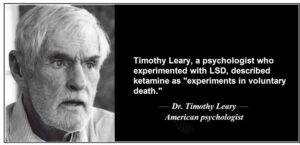This site uses affiliate links to Amazon.com Books for which IANDS can earn an affiliate commission if you click on those links and make purchases through them.
1. Introduction to Psychedelics and NDEs
Near-death experiences can be induced using a drug called ketamine which blocks receptors in the brain for the neurotransmitter glutamate. All features of a classic near-death experience can be produced by the intravenous administration of 50 – 100 mg of ketamine. Ketamine is a short-acting, hallucinogenic, dissociative anesthetic related to phencyclidine (“angel dust” or “PCP”). Both drugs are arylcyclohexylamines – they are not opioids and are not related to LSD. In contrast to PCP, ketamine is relatively safe, an uncontrolled drug in most countries, and remains in use as an anesthetic for children. Anesthetists attempt to prevent patients from having near-death experiences (so-called “emergence phenomena“) by the co-administration of benzodiazepines and other sedative substances which produce “true” unconsciousness rather than dissociation.
2. Ketamine and NDEs
Ketamine produces an altered state of consciousness that is very different from that of the “psychedelic drugs” such as LSD. It can produce all the features of the near-death experience, including travel through a dark tunnel into light, the conviction that one is dead, telepathic communion with God, visions, out-of-body experiences and mystical states. If given intravenously, it has a short action with an abrupt end. One ketamine user talked of:
“…becoming a disembodied mind or soul, dying and going to another world.”
Childhood events may also be re-lived. The loss of contact with ordinary reality and the sense of participation in another reality are more pronounced and less easily resisted than is usually the case with LSD. The dissociative experiences often seem so genuine that users are not sure that they have not actually left their bodies.
Timothy Leary, a psychologist who experimented with LSD, described ketamine as:
“… experiments in voluntary death.”
One ketamine user, who reported a classic near-death experience, stated:
“I was convinced I was dead. I was floating above my body. I reviewed all of the events of my life and saw a lot of areas where I could have done better.”
Psychiatrist and transpersonal psychologist Stanislav Grof states:
“If you have a full-blown experience of ketamine, you can never believe there is death or that death can possibly influence who you are.”
Ketamine allows some patients to reason that:
“… the strange, unexpected intensity and unfamiliar dimension of their experience means they must have died.”
Ketamine HCl, available as 100mg/ml injectable under the trade name Vetalar (Parke-Davis) and Ketaset (Bristol) is used in veterinary work as a general anesthetic. The dosage used produces analgesia but with normal pharyngeal and laryngeal reflexes. It only causes mild respiratory depression. The advantage of this anesthetic is that you don’t need to support respiration while performing any procedures. This allows for a one-man operation. It is so widely used in the Veterinary profession that I don’t think abuse will cause it to be discontinued, but I can see that it will one day be serialized and accountable as a controlled substance.
Because the near-death experience and its corresponding out-of-body experience can be induced using drugs, many scientists conclude incorrectly from this that such mystical experiences can be reduced solely to brain chemistry. The same incorrect logic can be applied to just about any human experience. This would mean that every human experience is only a brain chemical function. Anybody who has ever experienced such things as synchronicity, out-of-body experiences, near-death experiences, after-death communications, or anything remotely paranormal, are only experiencing a phenomenon resulting from only brain chemicals. Many researchers use scientific reductionism to reduce everything to its most basic elements. There is no doubt that the near-death experience involves the mind/brain connection, but to say that the mind is nothing more than a brain and chemicals is to assume a lot. The fact that near-death experiences can be reproduced in the laboratory proves that they are a real scientific phenomenon. By reproducing the near-death experience in a laboratory setting, it satisfies the requirements of the scientific method. However, the scientific method has its limitations. It can only measure what is measurable through the senses. Those people who had a near-death experience, know it actually transcends the physical senses and the body all together and it cannot be adequately measured. What many scientists fail to realize is this: Just because it cannot be measured, does not mean it is non-existent.
I also want to make it clear that I do not advocate the use of potentially harmful drugs in any way. The material in this article is not necessarily provided here for people to take ketamine in order to induce a near-death experience. This material is for informational purposes only. I have never taken ketamine myself because I have medical conditions which prevents me from doing so. However, ketamine can be a safe drug when used properly.








